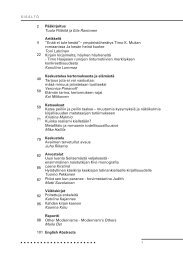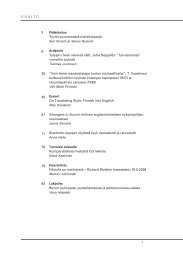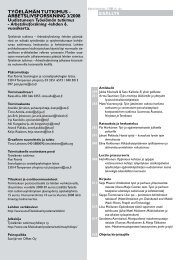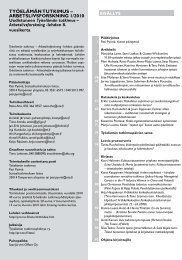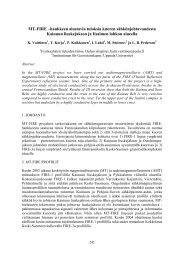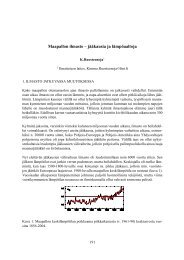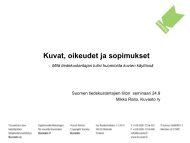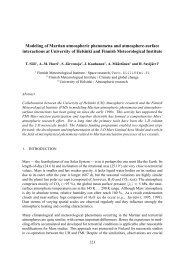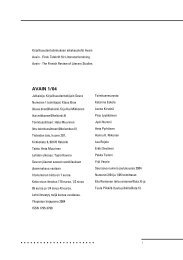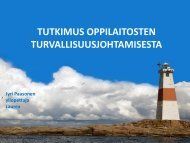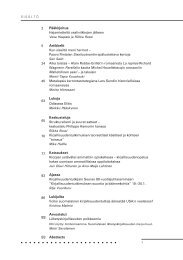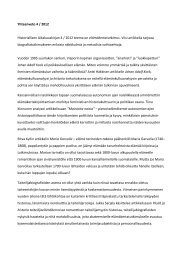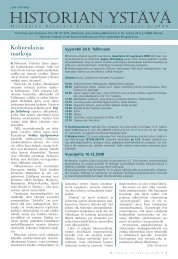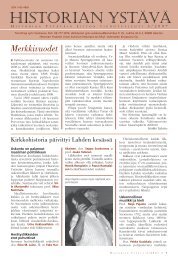TYÃELÃMÃN TUTKIMUS - ARBETSLIVSFORSKNING 2/2008
TYÃELÃMÃN TUTKIMUS - ARBETSLIVSFORSKNING 2/2008
TYÃELÃMÃN TUTKIMUS - ARBETSLIVSFORSKNING 2/2008
Create successful ePaper yourself
Turn your PDF publications into a flip-book with our unique Google optimized e-Paper software.
Työelämän tutkimus – Arbetslivsforskning 2/<strong>2008</strong> (6. vsk.)<br />
Kirjallisuus<br />
Cha n d l e r , A.D. (1962). Strategy and structure. Cambridge, Mass.: MIT Press.<br />
Co l l i n s, J. (2004). Hyvästä paras. Miksi jotkut yritykset menestyvät ja toiset eivät? Jyväskylä: Gummerus Oy.<br />
Dun p h y, D. (1996). Organizational change in corporate settings. Human Relations, 49, 541–552.<br />
Dun p h y, D.C. & Sta c e , D.A. (1988). Transformational and coercive strategies for planned organizational change: Beyond the O.D.<br />
model. Organizational Studies, 9, 317–334.<br />
Fe l d m a n , M.S. (2000). Organizational routines as a source of continuous organizational change. Organizational Science, 11, 611–629.<br />
Fe l d m a n , M.S. (2004). Resources in emerging structures and processes of change. Organizational Science, 15, 295–309.<br />
Fr o h m a n , A.L. (1997). Igniting organizational change from below: The power of personal initiative. Organizational Dynamics, 25, 39–53.<br />
Ga l b r a i t h, J.R. (1977). Organization Design. Reading, Mass.: Addison-Wesley.<br />
Inn s , D. (1996). Organisation development as a journey. Teoksessa Oswick, C. & Grant, D. (toim.): Organisation development.<br />
Metaphorical explanations. (s. 20–34). Lontoo: Pitnam.<br />
Ko t t e r , J.P. (1996). Muutos vaatii johtajuutta. Helsinki: Oy Rastor Ab.<br />
Mar s h a k, R.J. (1993). Lewin meets Confucius: A re-view of the OD model of change. The Journal of Applied Behavioral Science,<br />
29, 393–415.<br />
Miles, R.H. (2001). Beyond the age of Dilbert: Accelerating corporate transformations by rapidly engaging all employees. Organizational<br />
Dynamics, 29, 313–321.<br />
Mi nt z b e r g , H. (1983). Structure in fives. Designing effective organizations. London: Prentice Hall.<br />
Mo r l e y, M.J. (2004). Contemporary debates in European human resource management: Context and content. Human Resource<br />
Management Review, 14, 353–364.<br />
No n a k a , I. & Ta k e u c h i, H. (1995). The Knowledge Creating Company. How Japanese companies create the dynamics of innovation.<br />
New York: Oxford University Press.<br />
Or l i k o w s k i, W.J. (1996). Improvising organizational transformation over time: A situated change perspective. Information Systems<br />
Research, 7, 63– 92.<br />
Ro m a n e l l i, E. & Tu s h m a n , M.L. (1994). Organizational transformation as punctuated equilibrium: An empirical test. Academy of<br />
Management Journal, 37, 1141–1166.<br />
Sa a r i, E. (1995). Voidaanko tutkimusryhmiä perustaa? Tapaustutkimus Valtion teknillisen tutkimuskeskuksen metallilaboratorion<br />
ryhmäkokeilusta vuosina 1989– 1991. VTT Tiedotteita 1627. Espoo: VTT Offsetpaino.<br />
Sa a r i, E. (2003). The Pulse of Change in Research Work. A Study of Learning and Development in a Research Group. Helsinki: Helsinki<br />
University Press.<br />
Sa a r i, E. & Ta l j a, H. (2007). Tutkijoiden ja johdon todellisuudet tutkimusorganisaatiossa – kommunikaatiokuilusta keskinäiseen<br />
dialogiin. Tieteessä tapahtuu, 7, 39–43.<br />
Sch e i n, E. (2001). Yrityskulttuuri – selviytymisopas. Tietoa ja luuloja kulttuurimuutoksesta. Helsinki: Laatukeskus.<br />
Ta l j a, H. (2006). Asiantuntijaorganisaatio muutoksessa. Espoo: Valtion teknillinen tutkimuskeskus, Publications 620.<br />
Ti s s a r i, T. (2002). Coevolutionary approach for implementing organizational change – case study on a business process change in<br />
a large organization. Espoo: Teknillinen korkeakoulu. Acta Polytechnica Scandinavica, Industrial and Business Administration<br />
Series no: 11.<br />
Ts o u k a s , H. & Ch ia , R. (2002). On organizational becoming: Rethinking organizational change. Organization Science, 13, 567–582.<br />
Tu s h m a n , M.L. & Ro m a n e l l i, E. (1985). Organizational evolution: A metamorphosis model of convergence and reorientation. Research<br />
in Organizational Behavior, 7, 171–222.<br />
Va n d e Ve n, A. H. & Po o l e , M.S. (2005). Alternative approaches for studying organizational change. Organization Studies,<br />
26, 1377–1404.<br />
We i c k, K.E. (1995). Sensemaking in organizations. London: Sage.<br />
We i c k, K.E. & Qu i n n, R.E. (1999). Organizational change and development. Annual Review of Psychology, 50, 361–386.<br />
katsauksia ja keskustelua<br />
215




